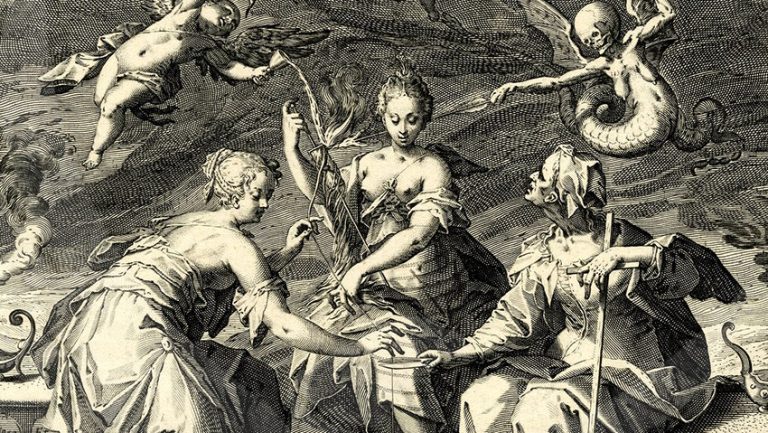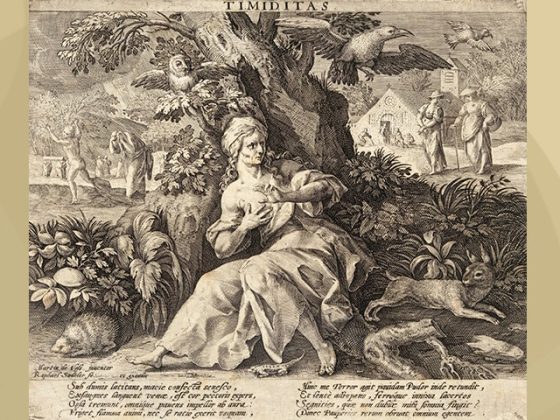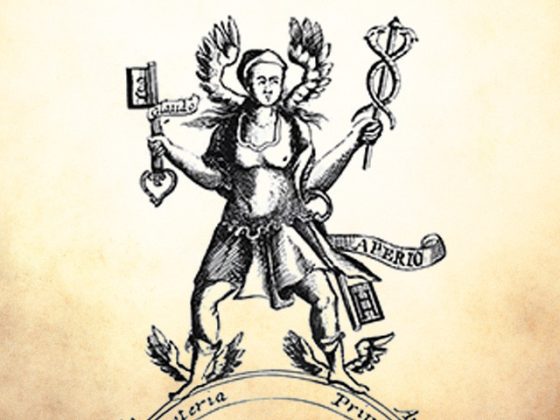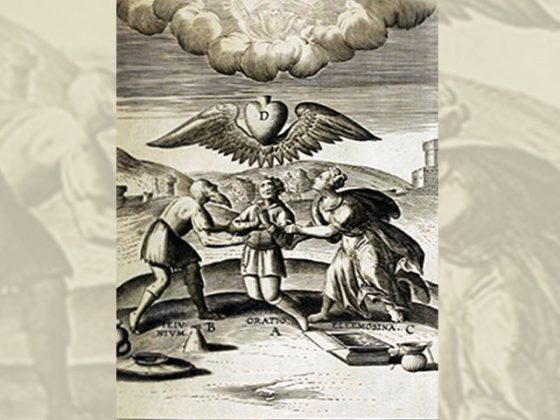Queridos amigos/as:
The present engraving is the result of the collaboration of three artists: the scholar Joris Hoefnagel ─Flemish poet, musician and painter, (1542-1600)─, the German painter Hans Von Aachen (1552-1615)─ and the engraver Aegidius Sadeler II ─Flemish engraver nicknamed “the Phoenix of engraving” (1568-1629)─.
The three projected a series of engravings to depict themes from the life of Jesus Christ, called Nicomaxia Vitae. The engraving I send is the cover. Possibly the project could not be carried out. This is the well-known drawing from the series.
Therefore, the title of this engraving is…
…NICOMAXIA VITAE
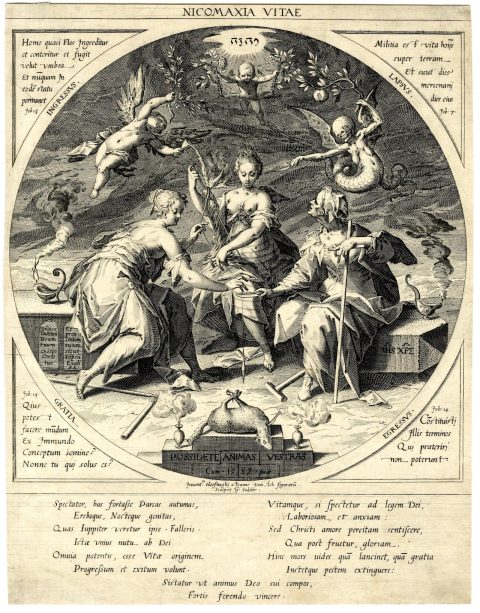
The title of this engraving is actually written in ancient Greek. In Latin it would be written nicomachia, which in Spanish would end up being Nicomachean.
Certainly, this word as a noun does not exist, but it appears very rarely as an adjective and refers to the work of Aristotle Nicomachean Ethics. Nicomachus is a man whose name means ‘the victor in battle'. But it is strange in a title that would be something like “the Nicomachean ethics of life”.
The word nicomachia, we repeat, is nowhere to be found, but it is clearly composed of nicos, which means ‘victory', ‘victor', and machia, which is ‘war, battle'. It could be translated as ‘the victory in battle' or ‘the victorious battle'. Vitae is Latin and means ‘of life'.
Therefore, nicomachia vitae could be translated as ‘the victorious battle of life', which gives it a more logical meaning than some other possible translation.
At the top we see the word TETRAGRAMMATON in Hebrew.
At the bottom left, on two tablets, there is a sentence that says:
Diliges Dominum Deum tuum ex toto Corde tuo
Et proximum tuum sicut te ipsum Exodi XX
The translation is: ‘You shall love the Lord your God with all your heart, and your neighbor as yourself' ─Exodus XX─.
In reality, these phrases are taken from Matthew 22:37-39, and in them Jesus summarizes all the Mosaic commandments expressed precisely in Exodus XX.
On the stone on the right, likewise, there is a mixture between Latin and Greek. Two groups of letters appear on two levels:
On the left is Ω and below IHS, on the right Ω and below ΧPΣ.
- The omega is an exclamation “OH!”
- IHS is the Latinized version of the trigram that synthesizes the name of Jesus in Greek. Originally it was IHΣ, the first, second, and last letters of the Greek name of Jesus ─ the H in ancient Greek was a long E ─ but in Latin it ended up being interpreted as an H. Anyway it means ‘Jesus'.
- ΧPΣ is in Greek; they are the first, second, and last letters of the name Christós —letters ji, rho, and sigma.
In practice, this mixture means: “O Jesus! O Christ!”
Bottom center: POSSIDETE ANIMAS VESTRAS, ‘Possess your souls.'
Below are references to the date 1589 and the authors.
The four words: LAPSVS EGRESSVS GRATIA INGRESSVS I would translate as ‘fall, exit, grace, entrance'. I think this must be the correct order in which they should be read, since they look like a clockwork and start at the top right.
Next to LAPSVS is a quote from Job 7:
Militia est vita hominis super terram, et sicut dies mercenarii dies eius.
The literal translation would be: ‘Man's life on earth is [like] military service, and his days are like those of a mercenary” (Job 7).
Next to EGRESSVS is another quote from Job 14:
Constituisti Illis terminos
Qui praeteriri non poterunt.
‘You have set limits for them that they cannot cross'.
Next to GRATIA another quote from Job 14
Qius [Quis] potest facere mundum ex immundo conceptum semine? Nonne tu qui solus es?
It means: ‘Who can make clean what has been born of an unclean semen? Except foryou who are the only one?' ─Job 14:4─.
Finally, next to INGRESSVS is another quote from Job 14:
Homo quasi flos ingreditur et conteritur et fugit velut vmbra
Et nunquam in eodem statu permanet. Job 14.
‘Man comes forth like a flower and fades away, and flees like a shadow, and never remains in the same state' ─Job 14:2─.
At the bottom of the engraving are these sentences:
Spectator, has fortasse parcas autumas, Ereboque, Nocteque genitas, quas Iuppiter veretur ipse. Falleris ista unius nutu ab Dei.
Omnia potentis. esse Vitae originem.
Progressum et exitum volunt.
Vitamque, si spectetur ad legem Dei,
Laboriosam, et anxiam:
Sed Christi amore percitam sentiscere,
Qua post fruetur, gloriam.
Instetque pestem extinguere:
Sistatur ut animus Deo sui compos, Fortis ferendo vincere.
‘Spectator, you may think that these Parcae, born of Erebus and Night, are the same as Jupiter himself fears. You are wrong.
All these things, by the will of the one powerful God, are intended to be the origin, the progress, and the end of life. And [they] want that, if one turns to the law of God, life [be] laborious and painful, but stimulated by the love of Christ, [so] that one begins to perceive that he will later enjoy glory.
Here you see how much death destroys and how much grace is applied to extinguish the pestilence:
Let it be stopped so that the soul that has its God advancing with strength [may] overcome.'
What is all this, dear reader?
This engraving shows us the three Parcae, weavers of our destiny. We have been brought from the firmament by the very TETRAGRAMMATON or JEHOVAH of the armies. That is why a Cherub appears representing this coming to life with the name of God above his head.
On the left side appears another Cherub representative of LIFE, and on the right side a creature with a skull instead of a head. These are the two sides of existence.
The Cherub on the left has a laurel branch, signifying the triumph, in one of his hands, and in the other he carries a chalice with which he pours wine on a fire held by the Parcae. It is the fire of temporal life.
On the right side, the creature representing death holds in his left hand a branch of an apple tree that alludes to sexuality, and with the other he throws a dart at one of the Parcae. This is the dart of lustful sexuality that has already touched one of the Parcae on her neck.
For this reason, near the Parca on the left side there is a lit lamp marking the beginning of life, while on the right side, near the other Parca, an extinguished lamp appears and the face of the Parca is aged. This is the beginning of our old age.
Between two small candlesticks we can see a lamb representative of the Christic forces, but tied, as if ready to be sacrificed. That lamb is our intimate Christ who sacrifices himself for us in spite of our mistakes and imprudence. For this reason, next to it the inscription reads: “POSSESS YOUR SOULS”, which in other words means: “SEEK YOUR INTIMATE CHRIST to give meaning to your life”.
The Parca on the right, whose face is mired in old age, holds a cross in one of her hands, an eternal symbol of the continuity of life.
The title of our engraving invites us to fight for our lives, to fight for our Christ, and the Latin words, translated, tell us that everything is, in truth, an absolute vanity…
Notice that many of these Latin and biblical phrases refer to Job and his sufferings when God tested him in his faithfulness to His commandments.
I now give you a few sentences for your reflection:
“Ingenuity is made up of one-third instinct, one-third memory, and one-third will.”
C. Dossi
“It is easier to judge a man's wit by his questions than by his answers.”
Duke of Lewis
“The opposite happens with wit than with money: the less you have, the more content you are.”
P. Masson
“There was never great ingenuity without a little madness.”
Seneca
“Ingenuity sometimes makes up for genius; it is like water that offers us great depth, reflecting the immensity of the firmament to us.”
Balmes
DE PROFUNDIS.
─‘From the depths’─.
KWEN KHAN KHU


